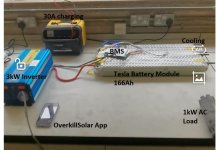Anil
1 µW
Dear All,
I benefited a lot from what I read in this platform during the building the test rig.
I am working on improve the cooling of a Tesla battery with different fluids or nano particles. I have been using BMS from Overkill Solar for a my experiment studies initialy. As you know, OverkillSolar BMS can provide maximum 100amp and peak 240amp.
It is written in the datasheet that the Tesla battery module can reach up to 4C discharging rate. So it can provide max 664 amps.
It does not make sense to run it at such a high C rate for battery life, but since I am doing experiment for my university Final year project, I want to run tests at 0.5C, 1C, 1,5C 2C and 3C. (83, 166, 249, 332, 498 amp respectively)
I added the photo of the my initial system. I'm looking for a automotive BMS that can take this up to 700amp.
If I can find a BMS that can go 700amp, I will find the load accordingly and enlarge the system.
I will wait for suggestions from knowledgeable technical people like you. Unfortunately, university professors have only theoretical knowledge.
Which brand BMS can output 700/500 amp for single battery module.
Kind Regards.
Alan

I benefited a lot from what I read in this platform during the building the test rig.
I am working on improve the cooling of a Tesla battery with different fluids or nano particles. I have been using BMS from Overkill Solar for a my experiment studies initialy. As you know, OverkillSolar BMS can provide maximum 100amp and peak 240amp.
It is written in the datasheet that the Tesla battery module can reach up to 4C discharging rate. So it can provide max 664 amps.
It does not make sense to run it at such a high C rate for battery life, but since I am doing experiment for my university Final year project, I want to run tests at 0.5C, 1C, 1,5C 2C and 3C. (83, 166, 249, 332, 498 amp respectively)
I added the photo of the my initial system. I'm looking for a automotive BMS that can take this up to 700amp.
If I can find a BMS that can go 700amp, I will find the load accordingly and enlarge the system.
I will wait for suggestions from knowledgeable technical people like you. Unfortunately, university professors have only theoretical knowledge.
Which brand BMS can output 700/500 amp for single battery module.
Kind Regards.
Alan



